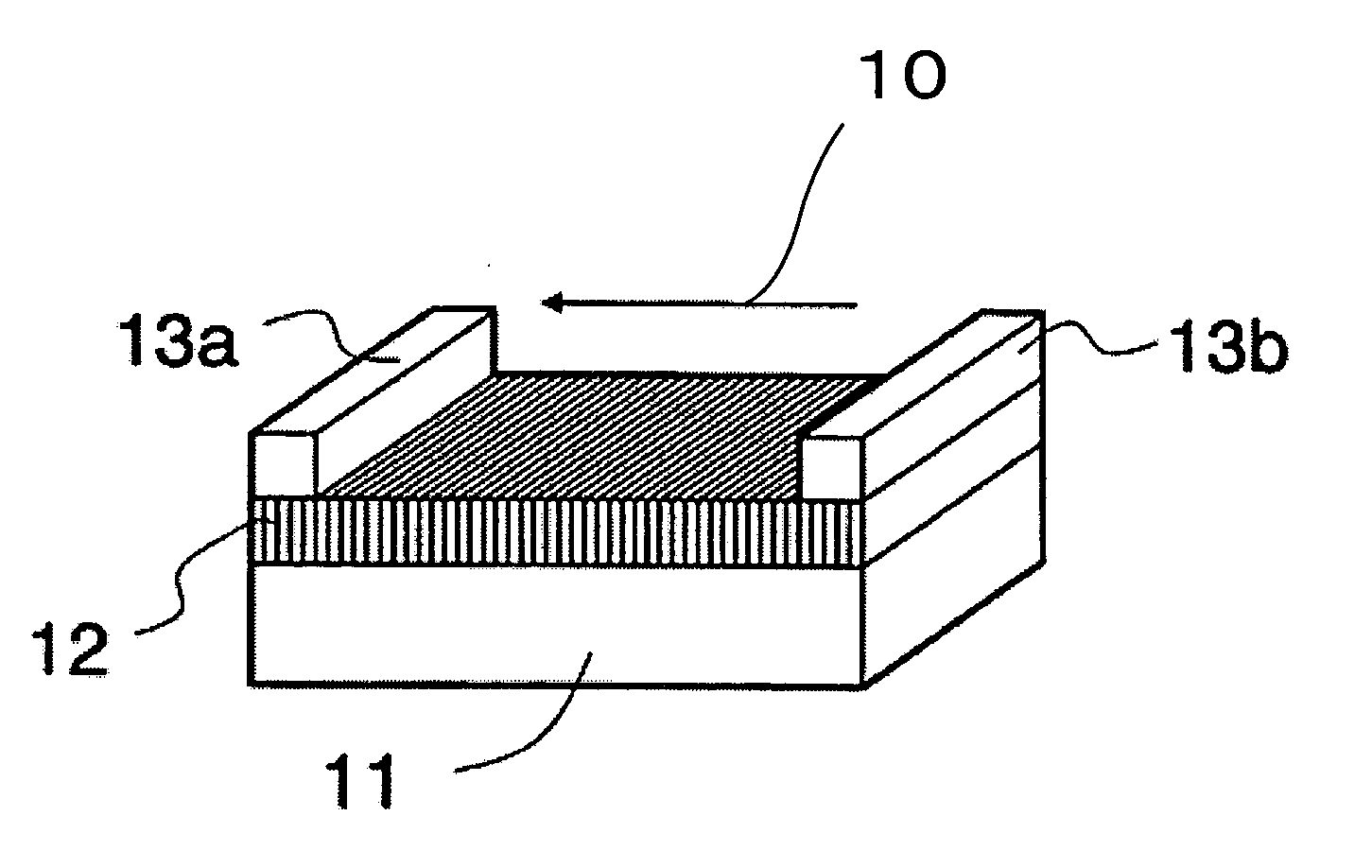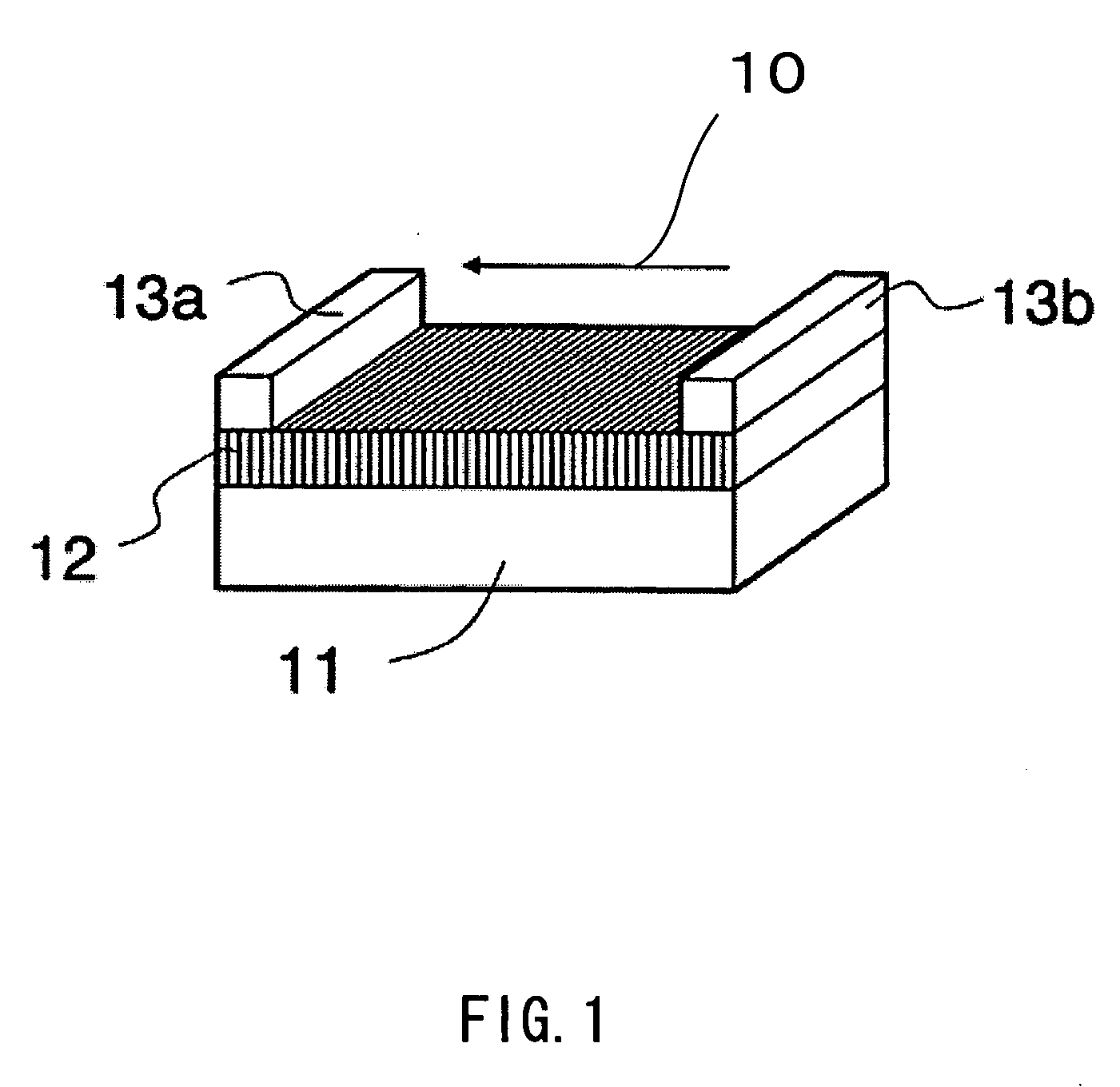Thermoelectric conversion device, and cooling method and power generating method using the device
- Summary
- Abstract
- Description
- Claims
- Application Information
AI Technical Summary
Benefits of technology
Problems solved by technology
Method used
Image
Examples
embodiment 1
[0041] A thermoelectric conversion device shown in FIG. 1 is furnished with a plate-shaped substrate 11, a thermoelectric-conversion film 12 on the substrate 11, and a pair of electrodes 13a, 13b arranged to the right and left of the substrate 11 so as to be in contact with the thermoelectric-conversion film 12.
[0042]FIG. 2 illustrates a crystal structure of the thermoelectric-conversion film 12. The thermoelectric-conversion film 12 has a layered structure in which electrically conducting layers 22 and electrically insulating layers 23 are alternately arranged. In other words, the thermoelectric-conversion film 12 is made of a crystalline thin film in which the electrically conducting layers 22 and the electrically insulating layers 23 are alternately arranged.
[0043] In terms of crystallography, the interlayer direction, i.e., the direction perpendicular to the layer surfaces, is referred to as a c-axis direction 10. The pair of electrodes 13a and 13b are arranged so that current...
example 1
[0086] A film of layered oxide Na0.4CoO2 was deposited on a 10 mm-square and 100-μm-thick A plane substrate of sapphire Al2O3. The deposition was carried out by RF magnetron sputtering using a 4-inch-diameter Na0.5CoO2 sintered compact target.
[0087] Pre-sputtering was carried out at an output power of 60 W for 1 hour in an atmosphere gas containing 80% Ar and 20% O2 that was kept at 5.0 Pa. Thereafter, deposition was performed on the substrate heated to 700° C. over a duration of 5 hours under the same conditions as in the pre-sputtering. Subsequently, the heated thin film on the substrate was cooled for 2 hours to room temperature in an oxygen atmosphere. Consequently, a thin film having metallic luster and a film thickness of 1000 nm was obtained.
[0088] Energy dispersive X-ray fluorescence analysis confirmed that the composition ratio of Na and Co in the thin film was approximately Na:Co=0.4:1.
[0089] The result of the X-ray diffraction analysis for the Na0.4CoO2 thin film thus ...
example 2
[0103] Using a 4-inch target material composed of a sintered compact made of powders of CaO2 and Co3O4, a thin film having a film thickness of 1000 nm was grown on a sapphire M-plane substrate of 10 mm square and 100 μm thick under the same sputtering conditions as in Example 1.
[0104] Energy dispersive X-ray fluorescence analysis confirmed that the composition ratio of Ca and Co in this thin film was approximately Ca:Co=0.5:1. The result of X-ray diffraction analysis for this Ca0.5CoO2 thin film is shown in FIG. 9. Besides the diffraction peak originating from the sapphire substrate, only the peak indexed as (020) due to the diffraction from the thin film was observed.
[0105] This demonstrated that the Ca0.5CoO2 thin film was epitaxially grown so that its (010) plane became parallel to the substrate. In addition, four-axis x-ray diffraction analysis confirmed that the c axis of the crystal of Ca0.5CoO2 oriented in the plane of the thin film.
[0106] The Ca0.5CoO2 thin film had shown...
PUM
 Login to View More
Login to View More Abstract
Description
Claims
Application Information
 Login to View More
Login to View More - R&D
- Intellectual Property
- Life Sciences
- Materials
- Tech Scout
- Unparalleled Data Quality
- Higher Quality Content
- 60% Fewer Hallucinations
Browse by: Latest US Patents, China's latest patents, Technical Efficacy Thesaurus, Application Domain, Technology Topic, Popular Technical Reports.
© 2025 PatSnap. All rights reserved.Legal|Privacy policy|Modern Slavery Act Transparency Statement|Sitemap|About US| Contact US: help@patsnap.com



